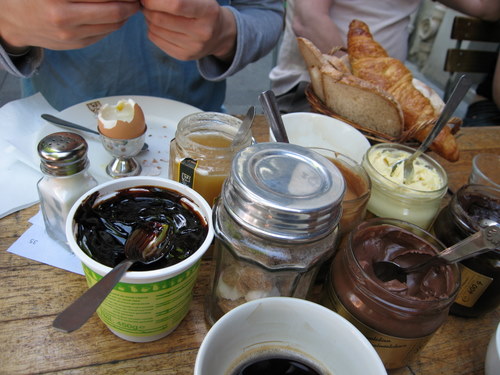I am starting my culinary adventure very soon (in a couple hours that is) and I am a bubbly mix of terribly excited and terribly scared. Yesterday, I attended my orientation where I was introduced to the curriculum at the school. "Not to worry, the local hospital is only a couple blocks away, and the doctors there are used to our students coming in, especially in the first weeks! They always seem to have very clean and clear cuts", I was told by one of the orientation speakers. I was waiting for the pause, and the grin. But there was none. This is no joke. The serious cooking has begun. I get my knife set tomorrow which is undoubtedly a sign that I have been initiated to the professional culinary world...
Before leaving I did get a chance to make a last dessert. While this it was no last supper, it did feel like it would be a while before I got to cook in my student kitchen again. We ended our meal with a sweet touch: dark chocolate pots de creme. It's really one of the easiest recipes I have ever made. You just have to prepare it a little bit in advance to make sure the concoction has the time to set. The chocolate was very rich, so serving it in small portions is a good idea.

Recipe (for 4) Adapted from the Plantation House Restaurant
4 oz. chopped dark chocolate
3/4 cups of whipping cream
2 egg yolks, slightly beaten
2 Tbsp. of granulated sugar
1/2 tsp. of vanilla extract
2 tsp of Grand Marnier
A dash of salt
Heat the chocolate in a double boiler, whisking until melted. Stir in the sugar and heavy cream, whisking until smooth. Beat a small amount of chocolate mixture into a bowl with the beaten egg yolks. Gradually add the egg-chocolate mixture back into double boiler pan. Whisk and cook for about 3 minutes over medium heat. Stir in the vanilla, Grand Marnier and salt. Strain through small sieve to remove any possible cooked egg lumps. Pour into small ramekins. Chill until firm (at least 2 hours) and top with a dollop of whipped cream and some chocolate shavings. Enjoy!




















 I'm proud to announce that chocolateshavings has joined the ranks of a highly talented and secretive organization that goes by the name of 'The Daring Bakers.' The Daring Bakers are an online community of people who love to bake. Once a month, a challenge is issued by the host for that month and everybody bakes, and then posts their finished product. It's a fun way to motivate us to bake more and try differentrecipes as well as interact with fellow bloggers.
I'm proud to announce that chocolateshavings has joined the ranks of a highly talented and secretive organization that goes by the name of 'The Daring Bakers.' The Daring Bakers are an online community of people who love to bake. Once a month, a challenge is issued by the host for that month and everybody bakes, and then posts their finished product. It's a fun way to motivate us to bake more and try differentrecipes as well as interact with fellow bloggers.








